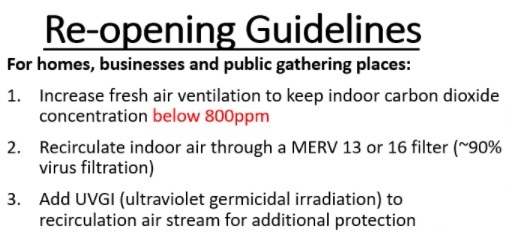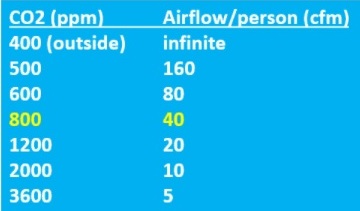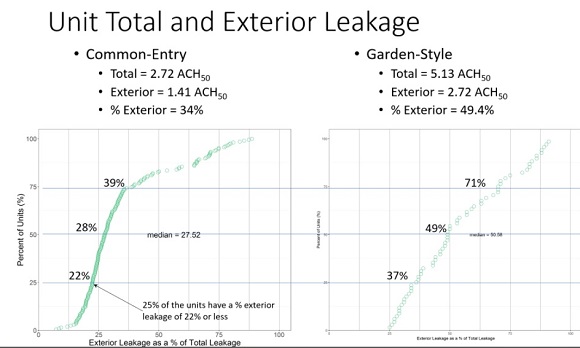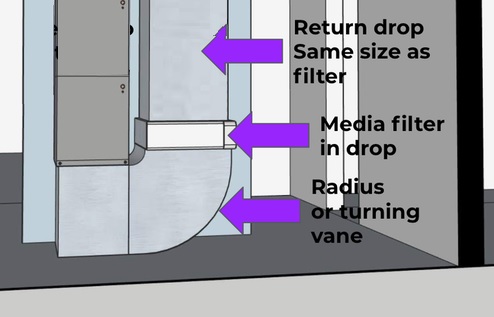 It’s amazing what one tiny little bug can do & the conversations it stirs up. In this case, it is all the talk about ventilation, filtration, masks, UV lights, social distancing, etc… I don’t think I have ever seen so many Indoor Air Quality “gurus” getting so much press in any 5 year period much less in just 5 months. Quite a lot of good has come out, but also some bad, but that is to be expected. The interesting thing is looking forward & what might be coming in the near future.
It’s amazing what one tiny little bug can do & the conversations it stirs up. In this case, it is all the talk about ventilation, filtration, masks, UV lights, social distancing, etc… I don’t think I have ever seen so many Indoor Air Quality “gurus” getting so much press in any 5 year period much less in just 5 months. Quite a lot of good has come out, but also some bad, but that is to be expected. The interesting thing is looking forward & what might be coming in the near future.
Quick History:
As many know, most codes & standards are updated every three years. In the case of Building Codes, these will generally see a slew of major changes or updates after a disaster; hurricanes, deck collapses, etc… The rest of the time though, the codes and standards are pretty much modified with little tweaks here & there. This might be the first time though that we may see an attempted major rewrite of a standard (yes I am thinking ASHRAE 62.1 & .2) due to an event – namely COVID19.
So why am I calling this the Great Ventilation Debate Part 2? Well back in 2014, after ASHRAE 62.2.2013 was released (where they arbitrarily raised the ventilation rate without any studies) there was a major backlash that occurred. For more on it – My Take: ACI & the Ventilation Debate. Fast forward 6 years & now is the time that they are looking into the 2022 standard. Now with everything going on, I don’t expect this to be a quite session especially with so many divergent views.
Is it Ventilation, Filtration, or?
Before we get into some of the issues, lets review a few quick points to avoid confusion & also look at some common terms.
- Ventilation – There are 3 general principles related to ventilation which involves replacing indoor air with outdoor (aka “fresh”) air; exhaust, dilution, & intake. This ventilation can be handled via mechanical means or natural means (i.e. opening a window – though the codes hardly recognize that as an option.)
- Filtration – Quite simply it is a way to clean air by trapping containments (like viruses, dust, smoke) generally via a filter.
- UV Lights – these are neither filtration nor ventilation related though they can be tied into either type of system. Some like to consider this “Purification”
- Wearing a Mask – technically a filtration device though effectiveness is debatable at best
- Social Distancing – neither
- Air Purifier / Cleaner / Comparetto Cube – only filtration by itself
- Companies leaving doors open during business hours – Ventilation
- ERV – combination of ventilation & filtration though there is a small issue where not only humidity but viruses can be reintroduced back into “clean air” stream
- HRV – ventilation only unless a filter is added
- Exhaust only – ventilation only
- Supply only / Economizer (only talking about one tied into HVAC system) – generally will be both as your are introducing exterior air which generally goes through HVAC units filter.
We need to raise ventilation rates:
I have caught at least two presentations by Ty Newell including one from my good friends at Green Home Institute where I think I got both these screen shots from. While both webinars were different based on the audience he was talking to, some information wasn’t. One thing is he believes that the Carbon Dioxide measurement is a good way of determining air freshness & if it is below 800 it reduces your chances of getting COVID by 20% assuming someone has it in the room. Sorry but you can’t reduce the risk if no one has it…


This chart is how he thinks we need to ensure that we are at or below 800ppm – by making sure we have 40 cfm of ventilation air per person. So a 3 bedroom, 2500 SF house would now require 160 CFM of air as compared to the 60 to 80 CFM required now…
The catch – can you imagine how much more humidity, much less other outdoor contaminant’s you would have to deal with? Just remember, unless you have a balanced ventilation system most “fresh” air you get is coming from your attached garage, attic, & crawl space. Shoot here is a graph from a recent PNNL Multi Family Compliance Study that was completed & where most “units” don’t have attached garages, attics, or crawl space – 65% & 50% essentially had their fresh air coming in from neighboring units. Heh, hope the neighbors don’t have it… 
With that said, I do think the 800ppm is a good metric – the biggest catch though is ventilation is rarely based on contaminants, but rather it is running all the time. This is especially true with residential which says you have to have X period, it doesn’t matter if you are home, live by yourself, everyone is at work, or even on vacation – they don’t allow for monitoring based systems to be used. So while you might only need so much (or none) at a certain time & more at another the unit doesn’t care.
Increased Filter Sizes are a Must:
No, I am not picking on the slide above, but rather the advice almost everyone is handing out – go out, buy & install a MERV 13 or better filter at least. I am not sure if ASHRAE or maybe even the ICC will specify this for new units, but it could be coming. Now for those of you with cheep 1″ filters & older systems not designed for the static pressure bumping up your filter can impose – DO NOT install this as you can cause your unit to essentially stroke out. Granted you will get a new unit that can handle it now, but…
Speaking of filters – Nate Adams came up with what he likes to call the Big ASS Drop aka BAD (Tweaked image of his setup shown below) where the return is as large as the filter. Can I simply say spot on? Do you realize how many issues this deals with & how this is one of the best & easiest practices to implement I have seen yet? Shoot this can even work on some of those older systems listed above & avoid them stroking out. Now as for the supply only ventilation (not good in all climates) & his thoughts on humidifiers, well we will talk later. 🙂 Don’t think it matters – check out Allison Bailes latest post on the Energy Vanguard blog – he has his filters in a different place but I think you will understand.

Pre / Carbon Filters:
I doubt this will make it into any code or standard, but if you live in an area that loves to burn (aka California &/or other wildfire prone areas), or are stuck with odors from say from your neighbors unit – you might consider a pre-filter made with charcoal. That can help eliminate that issue while also allowing your much larger and expensive filter to last longer. Yes they even make some for ERV’s & HRV’s for those with balanced ventilation.
UV Lights:
I also doubt this will make it in either & nor should it. Granted I am not a big fan of these but they have been known to help some people out. I don’t see them helping everyone, but I do believe they do have there uses. With that said, reminder that the UV light (UV-C) is not only dangerous to viruses & bacteria it also is to other biological things like humans. Place it where it will do the most good & no that is not by the filter but rather a little farther along – namely in the supply stream by the Coil & Condensate Pan. Remember there is more out there than just COVID like legionnaires which just loves standing water.
Make Things Simpler:
Robert Bean is one gentleman that definitely knows indoor comfort & ventilation. He is also one of a few individuals I will use to back check an idea or thought I might have. Well recently on Twitter he got on a roll about…
1/n .@GovCanHealth you must agree aerosol transmission is possible if you are advising Canadians that closed spaces with poor ventilation carries a higher risk… so why not define for citizens what is “poor ventilation” and why we should care? #COVID19
2/n without a definition of “poor ventilation” it is open to interpretation…can you see how lay people might read this then point innocently at supply air diffusers and return air grills and think… “must be good ventilation I can see the hardware”
3/n you should be drawing attention to poor ventilation but not leaving society guessing what that actually means.
4/n so why not come out and say “the virus can remain airborne traveling beyond 2m and without effective removal via the ventilation system can increase risk to occupants. Then go on to explain what effective ventilation is as per #ASHRAE guidance…
Nicely stated BUT
- Most individuals (even those installing them) don’t know what makes ventilation good or poor. Shoot some of the “simple” advice disseminated early on by many so called professionals had numerous unintended consequences.
- Increase MERV filters – oops see above
- Just set your economizers to wide open to increase ventilation – oops now business were dealing with heat, humidity, & comfort issues that their equipment couldn’t keep up with.
- Back to the good ole days with steam radiators – open up all the windows & doors to let the air flow through…
- Most ASHRAE documents (especially the standards) are all locked up behind a pay wall
- Even if you pay for said documents it can be very hard, if not impossible for many to interrupt
- Shoot let’s look at tweet 7/n “furthermore it’s almost impossible without instruments to assess ventilation efficacy” aka if you do have poor ventilation.
- I agree you basically do need equipment to see if things are functioning properly, but that should have been dealt with during the original design & setup plus ongoing maintenance
- I would also add, it doesn’t matter if you have the instrument’s to determine ventilation flow, etc… like many of us do, if you don’t know what the reading should really be. 100 CFM here is good right, but that 75 over there is… which could easily be flipped, to much or even to little
- As Ty Newell points out, Ventilation only gets you a 20% reduction – you still need to filter that air & let’s not also forget that there are still things far worse than COVID to deal with.
So yes, let’s make things simpler for not only bureaucrats trying their best to help / give advice, but also for the HVAC technicians / designers, business owners trying to figure out what to do, etc…
Simulations / Animations to the rescue:
Yeah that would be a no for most. Remember the saying Garbage In = Garbage Out, well unfortunately that is what many of those simulations are. With that I have seen some good ones where they weren’t trying to scare the crap out of someone for example by figuring our return locations and air flow. FYI – before you freak out looking at this huge plume coming from someone, find out the science behind it. Shoot where are the studies that show that on average this many particles are released by breathing through ones nose, mouth, or via cough – I mean we have done those right as we are 8+ months in?
What should be addressed / How can we make things Simpler?
I am sure a few are going, well it’s easy to cast stones – so what would you do? Or hey you never really touched on some other key issues like NO2, combustion, electrify this, – you know they are going to be part… Well as this piece closes on 2000 words, with so much left to cover look for at least a part 2 where we will cover a lot of those topics. With that we would love your .02 – you think we are close to the mark, what do you think should be addressed, do you think we should bump levels up, or… If so please leave a comment below.

My comments from Twitter:
Good discussion!
Your most important point imho: we can measure this now! Staying under 800 ppm CO2 strikes me as a good metric.
Note that Richard Rue of Energy Wise in TX found years ago that this could be done in larger volume homes simply by mixing with the AHU.
We’ve found the same thing. This is good because mixing is fairly easy: turn up the air handler speed. Then you also get better filtration, often approaching or exceeding tge 4-6 ACH
@j_g_allen
and
@ShellyMBoulder
are discussing.
With a scuttle you get more outside air too.
Adding dedicated fresh air systems (ERV, HRV, ventilating dehumidifier) to most existing homes is not a realistic target imho, and comes with challenges as you mentioned of dealing with humidity and increased heating and cooling loads from outside air.
Plus those systems often don’t get serviced, filters get severely loaded, and equipment often fails well in advance of a normal lifespan.
Since few monitor IAQ, no one knows when they fail. (Again, monitoring is critical!)
We like scuttles in part because if the HVAC is running, so is the fresh air.
Is a scuttle adequate for 800 ppm CO2? Usually with good mixing (AHU on 24/7) in our measurements with Foobot (using tVOC as a proxy), but be sure to measure!
If you need more, choose an option.
Then there’s UV.
@ShellyMBoulder
helped me understand this a great deal.
Basically, if you insist on using them for residential, you really want UV-C aka 254 nanometer lights. Not the 185 nm that make ozone.
Ozone can cause severe respiratory problems for some people, it should be avoided. One of the HVAC 2.0 contractors landed his wife in the hospital because of an ozone generating UV light, it triggered her asthma.
This brings me to a major concern about residential UV: many practitioners are not expert in using UV: the odds of them choosing a 185 nm light (or getting one because 254 nm is out of stock) or replacing a 254 with 185 at relamping, are high. This doesn’t meet “do no harm” imho.
Furthermore, UV shouldn’t hit anything sensitive to it (many/most pieces of residential HVAC equipment are sensitive), so weird chemicals can off gas or equipment life can be shortened. Again, fails do no harm imho.
And lastly, the levels of UV have to be high enough to actually “kill” viruses (a term that is debatable but often used, as viruses aren’t really alive without a host, inactivate may be a better word.)
Determining that level requires design, which few if any systems will get.
So my position on residential UV is that it should be avoided. There are too many ways it can fail the do no harm test.
On commercial, it can be useful, if designed well.
In homes I think we should stick to the “holy trinity of IAQ”: filtration, fresh air, humidity control.
Thanks for the thoughtful post Sean!
Great points above – quick question on where I recommended placement (by coil & condensate pan) I have never heard that it would be a bad area much less be affected, have you? Thanks
Furthermore, UV shouldn’t hit anything sensitive to it (many/most pieces of residential HVAC equipment are sensitive), so weird chemicals can off gas or equipment life can be shortened. Again, fails do no harm imho.
And lastly, the levels of UV have to be high enough to actually “kill” viruses (a term that is debatable but often used, as viruses aren’t really alive without a host, inactivate may be a better word.)
Determining that level requires design, which few if any systems will get.
Ozone can cause severe respiratory problems for some people, it should be avoided. One of the HVAC 2.0 contractors landed his wife in the hospital because of an ozone generating UV light, it triggered her asthma.
Thanks for chiming in & reposting your tweets – lots of good stuff.
Agree it is a great metric but as pointed out we can’t & don’t base ventilation needs off “measurables” (at least residential) – commercial sometimes does, but in some cases to late. Years back I was at a mini conference held at a refurbished train station(?) which as I recall got LEED certified, etc… One of their big keys was we added in this sensor that controls ventilation based mainly on CO. Mind you there was a ton of people there & about halfway through I started getting tired along with others – nope it wasn’t the presentation. I would say about 10 minutes later you could here the ventilation system finally kick in & 30 minutes after that the tiredness had started to wear off.
This brings up another catch – where do we measure from? Most systems might not notice CO is getting higher say in the Great room / Kitchen area when a party is going on, or the bedrooms are to high at night. Then of course we also need trips for VOC’s &…